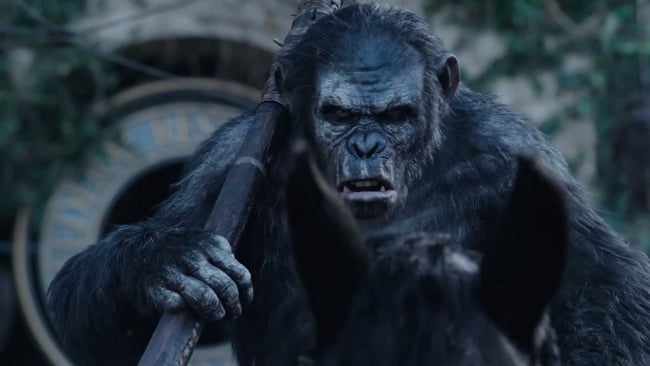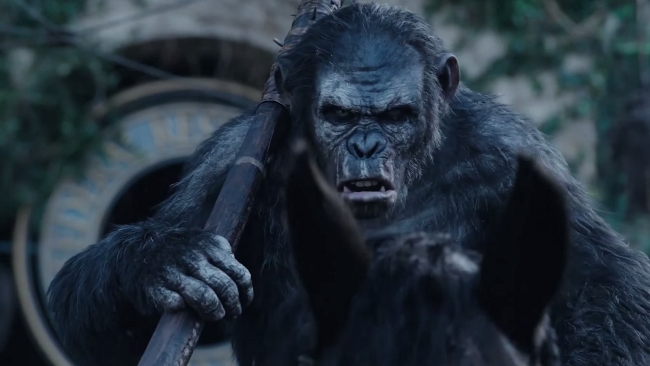
 Dawn of the Planet of the Apes
Dawn of the Planet of the Apes
Weta Digital is at it again! This time, the red-hot VFX house is inventing new ways to overrun the Earth with primates, as evidenced by an illuminating behind the scenes featurette for Dawn of the Planet of the Apes.
It's summer, which means it's once again Weta Digital's time to shine. While 'Weta Digital' isn't a household name, if you're a fan of big budget Hollywood blockbuster entertainment, you've no doubt marveled at Weta's handiwork: The Lord of the Rings trilogy, The Hobbit movies, the Iron Man movies, Wolverine, Man of Steel, Prometheus, Avatar, the list goes on and on.
Founded by Peter Jackson and fellow New Zealand filmmakers Richard Taylor and Jamie Selkirk way back in 1993, the powerhouse VFX wing of Weta (which also has divisions that run the gamut of film production), Weta Digital has staked a leadership position in the industry with its stellar work, innovation, and growing collection of hardware, highlighted by five Academy Awards for Best Visual Effects.
Weta Digital once again finds the spotlight with its groundbreaking efforts on Dawn of the Planet of the Apes, the next installment of the franchise reboot. The first in the series, Rise of the Planet of the Apes, was one of the surprise hits of 2011, garnering critical acclaim while captivating audiences with a riveting mix of action, smart storytelling, and truly believable CGI apes.
Innovate to Amaze
Part of the Weta Digital formula is to actively research and discover new visual effects techniques in a near-constant process of innovation, including scientific and academic research and developing its own software. This focus on the next way of doing things appears to be a necessity, as Hollywood tries to one-up itself at every turn, and Dawn of the Planet of the Apes is no exception, as it represents a more grandiose and epic vision than its predecessor. More scale, more scope, more apes, more demanding production requirements to challenge the expert artists and technicians at Weta.
In the accompanying behind the scenes featurette (found at the end of this article), DOPTA director Matt Reeves reveals that Weta was more than up for the task: "The thing that happened between Rise (of the Planet of the Apes) and our film is that Weta has taken a quantum leap forward."
MASSIVE Improvements
One of Weta Digital's inhouse tools, MASSIVE (Multiple Agent Simulation System in Virtual Environment), was first developed to realize Peter Jackson's vision of The Lord of the Rings films, enabling the creation of thousands of 'agents' that behave and interact with each other and the environment based on fuzzy logic and a set of pre-defined rules. To some extent, system is calling into presence pre-recorded clips, mainly derived from motion capture, but that doesn't diminish the achievement in any way.
Faced with the enormous task of making this community of forest-dwelling apes pass the eye test, Rise of the Planet of the Apes marked the first time that Weta brought its MASSIVE system out of the studio and on location. Weta used the lessons learned from ROTPOFA and adapted its motion capture plan for Dawn of the Planet of the Apes a shoot almost entirely made up of real world exterior locations.
To make it work, Weta Digital employed dozens of wireless 3D cameras to faithfully capture the actors playing the apes, who donned motion capture suits with active marker strands, measuring position, velocity and acceleration even if the markers were obscured from camera view, and witness cameras mounted to the suits to capture facial mocap information.
In post for DOTPOTA, Weta Digital used the occasion as an opportunity to roll out its impressive work in hair, skin, and moisture simulations. On the craft level, Weta's most stunning achievement may be in the arena of wet fur, as the rain-soaked environment called for, well, wet fur. The effect is extraordinary, and it's worth checking out the behind the scenes featurette for that section alone.
The Real Magic
The Weta Digital team wrote specialized software to bring all the elements together, but the goal here isn't technical mastery, but artistic achievement, to bridge that uncanny valley. For Weta, it's about trying to get as much of the actors' performances to translate, so the final result is a harmonious marriage of humanity and digital creation, as noted by director Reeves: "That is the amazing part of what Weta is doing...is finding a way in which they can take the parts of the actors and the parts of the apes and meld them in such a way that emotion comes through. Seeing the results is incredibly exciting."
Check out this behind the scenes VFX featurette and see the results for yourself.
Tags: Technology


Comments